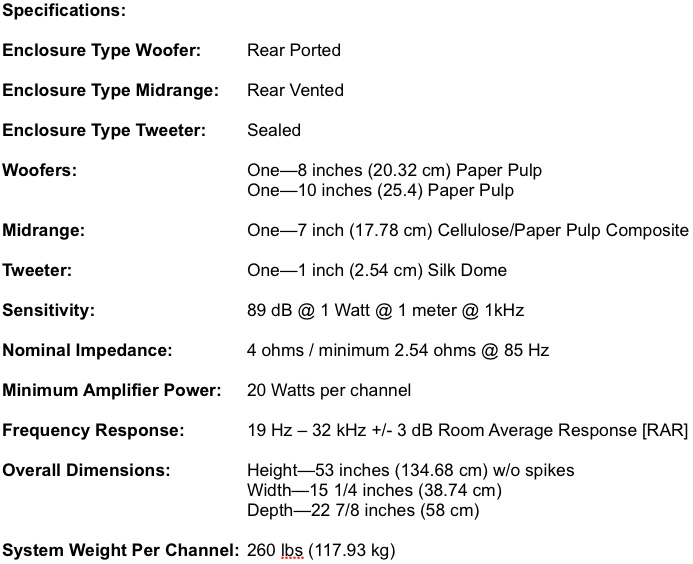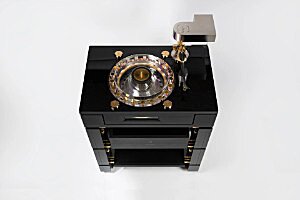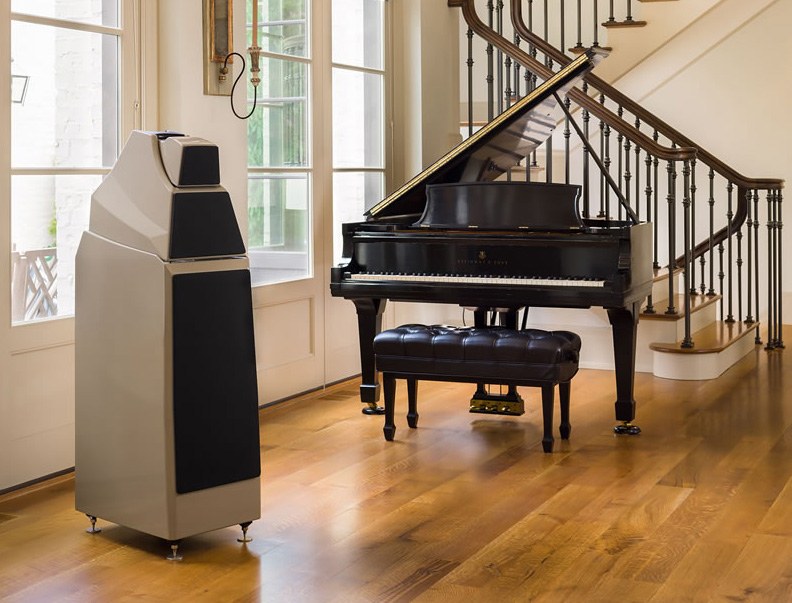

2017 – It is very difficult, even daunting, to update a classic. The physicians’ maxim of Primum non nocere (first do no harm) certainly applies here. An overly ambitious and inexperienced designer, in his zeal to advance the product with the “latest and greatest technology,” can inadvertently sacrifice the very qualities at the heart of the original’s intrinsic appeal. There is a certain wisdom and introspection that is inherent to all great designers. They know when real advancements are possible, and eschew the temptation to incorporate change for change’s sake. In the end, all great product designs are a deft admixture of art and science, technology and tradition, theoretical research and empirical testing.
Dave Wilson, who led the design for the original Alexia, embodies all these qualities. He was able to consolidate a large portion of his formidable experience and cumulative knowledge into its design. The result was a relatively compact loudspeaker that possessed the musical accuracy and resolution of its much larger siblings. His design process simultaneously built upon what he’d previously assimilated from industry-leading research and development combined with his then latest thinking on loudspeaker design and technology. He drew much of his inspiration and a fair amount of its technology from the Alexandria XLF, Wilson’s flagship at the time. When it was finished, the Alexia possessed much of the XLF’s unique combination of musicality and resolution, but in a much smaller and more domestic-friendly form factor.
Since its launch in the Fall of 2012, Alexia has been one of Wilson Audio’s most successful products, surpassing all sales forecasts. With a footprint not much larger than the Sasha W/P, the Alexia completely redefined what audiophiles thought was possible from a relatively compact design.
Daryl, Dave’s son and onetime protégé, understood what his father had created in the Alexia.
As is true for all great specialty companies, Wilson has not stood still. Since the Alexia’s introduction, Wilson’s technology has continued to evolve and advance in the areas of drivers, crossover analysis and design, time-alignment accuracy, and composite materials research. The last several years have been particularly fruitful for Wilson, led primarily by the research and development for the WAMM Master Chronosonic. The Master Chronosonic dramatically advanced the art of believable music reproduction. And, in turn, the Alexx, which was developed by Daryl Wilson alongside the Master Chronosonic, has itself profoundly advanced music reproduction in its respective category.
Daryl was eager to incorporate some of these same technologies and strategies into the Alexia platform to further advance its remarkable musicality and resolution. But, at the same time, he was determined to be vigilant in maintaining Alexia’s salient appeal. He thoughtfully examined every angle and scrutinized every curve. Every structural element was considered. Each of the crossover components—even the layout of its constituent parts—was assessed. Each of the metal mechanisms—large and small—were carefully examined for possible improvements. At the end of the design process, nearly everything in the Alexia has been reworked for the Series 2 with an eye toward more elegantly following the underlying technological function responsible for the original Alexia’s intrinsic musical rightness.
Daryl’s process, like his father’s before him, honors past accomplishments while, at the same time, employs Wilson’s latest cutting-edge technology. In many ways, this defines what we have come to call The Wilson Way™.
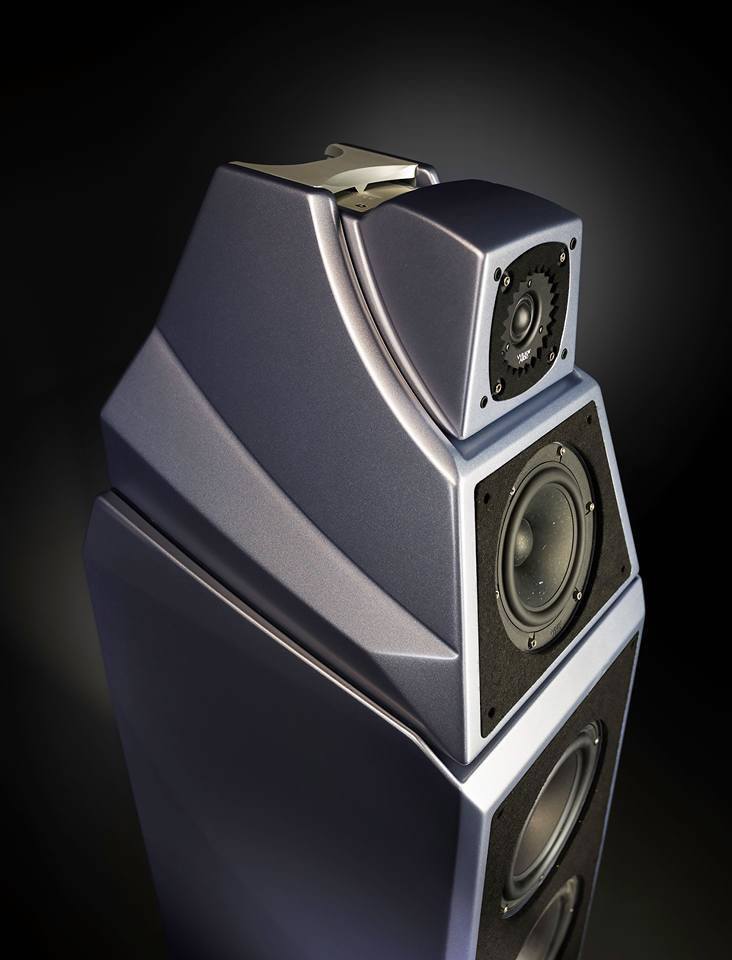
Wilson’s Latest Thinking in Composite Technology
Wilson continues to refine its strategy for building modular systems that permits the engineers to optimize the geometry and cabinet construction of each of the drivers’ enclosures. Central to this effort is applying the best composites, accounting for the differing applications presented by the range of frequencies covered by specific driver/enclosure combinations.
Wilson learned long ago that no composite is ideal for all applications. This understanding—seemingly unique to Wilson Audio—has led to the development of several composites, each optimized to the unique demands presented by a wide bandwidth transducer. Wilson’s materials-research facility is equipped with cutting-edge research tools, including the latest technology in Laser Doppler Vibrometry. This aerospace testing tool allows Wilson’s engineers to observe and correct cabinet vibrations at the level of nanometers (billionths of an inch).
The Alexia Series 2 cabinet is now the beneficiary of Wilson’s latest composite research—W-material, called such because of its relationship to the development of the new WAMM. W-Material possesses remarkable energy dissipation (damping) characteristics heretofore unobserved in any previous composite. Wilson’s engineers found that strategically placing W-material under the modules’ spike support areas greatly reduced unwanted energy at this critical mechanical interface.
W-Material joins Wilson’s existing cutting-edge composites, X-Material and S-material. The third generation of X-Material has its roots in its namesake: The X-1 Grand SLAMM. But this latest version is also a beneficiary of Wilson’s ongoing materials research. “X” is a material that at first seems paradoxical, but is, in reality, the result of decades of research into those areas of loudspeaker-enclosure science that truly contribute to musical veracity. No other material possesses its (seemingly contradictory) combination of extreme rigidity, monotonicity, modulus of elasticity, and intrinsic damping. X-Material is strategically utilized throughout the Alexia’s bass enclosure and tweeter module. Along with W, X is central to Alexia’s ultra-low resonance cabinet strategy.
The research surrounding the Sasha W/P led to the development of S-Material, which is used in the Alexia midrange baffle. S-material shares with X its damping characteristics, but has been optimized for the demands of the musically critical midrange, greatly contributing to the Alexia’s uncanny naturalness on voice and stringed instruments. The sum total of these changes is an enclosure that is, put simply, less audible than the already state-of-of the-art original Alexia. A sense of relaxed ease, tonal beauty without coloration, and a transient rightness pervade the Series 2’s musical presentation.
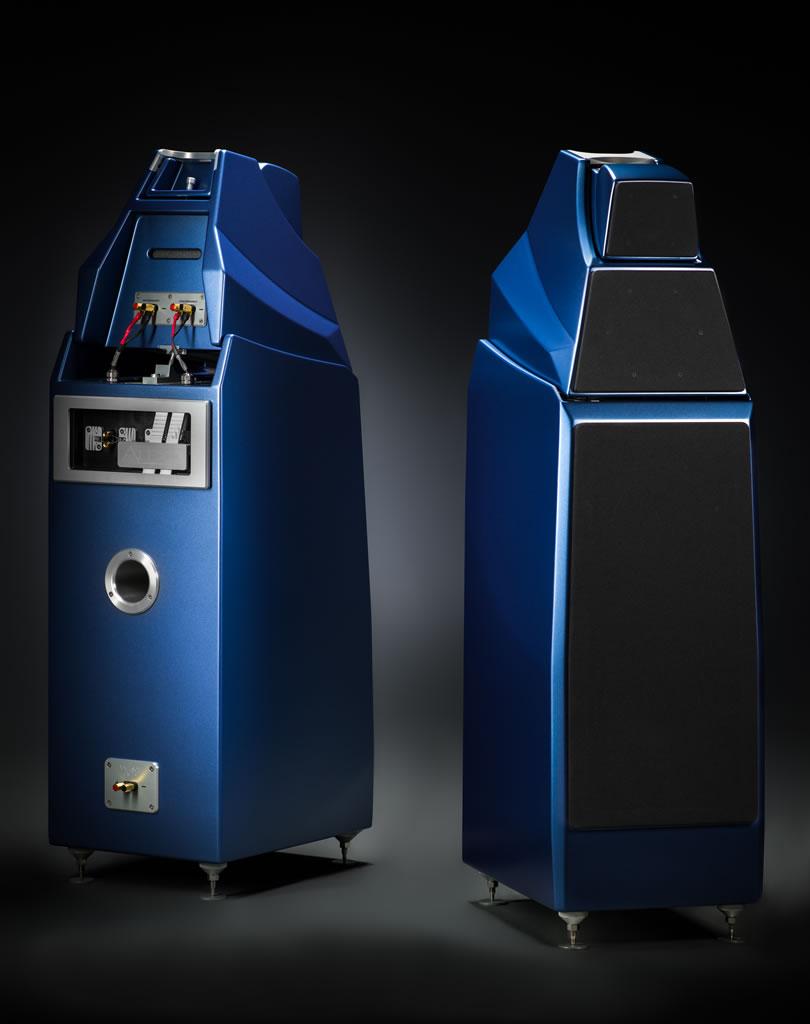
Increased Enclosure Volume and Advanced Bracing Strategies
When building ultra-performance yet very compact loudspeakers, space is the designer’s most valuable commodity. This is especially true of modular systems, such as the Alexia Series 2.
The Alexia Series 2 utilizes wire management hardware first pioneered for Dave’s Magnum Opus, the WAMM Master Chronosonic. This involves gas-tight cabinet exit hardware that reduces the number of needed solder joints and eliminates the need for a separately sealed chamber for the crossover module. This enables the enclosure volume to be increased without changing the external dimensions. As a result, Wilson was able to increase the midrange enclosure’s internal volume by 26.4%, and the woofer enclosure by 10.8%. This gave the freedom to Daryl and Wilson’s team of engineers to improve volume optimization for both the mid driver and the two woofers.
The midrange and woofer module’s internal bracing is also completely reworked. Internally, midrange walls are milled with complex geometric patterns. This improves internal diffusion and dramatically reduces unwanted reflected energy inside the cabinet. The greater volume also facilitates a new bracing geometry, which, in turn, allows for a single enclosure vent on the rear of the module. This larger vent replaces the two smaller vents on the Series 1. Similarly, the new internal geometry in the woofer cabinet, which includes an all-new cross brace strategy, reduces the resonant contribution of this module, and allows the rear port to be positioned in the center of the enclosure. The Alexia uses the Alexx’s low-frequency crossover mount strategy, eliminating the need for a separate bottom plate, which further improves rigidity and solidity in the bass enclosure.
The myriad improvements from these changes include faster, more dynamically expressive midbass, combined with a greater sense of ease and authority in the mid and deep bass. At the same time, the bass is more linear with less apparent room interaction. Since the center-mounted port loads symmetrically into the room for both channels, room-induced bass interactions are linearized channel-to-channel.
Similarly, the midrange is more impactful and, with transients settling more quickly into silence. Better cabinet tuning in the midrange, afforded by the greater cabinet volume, contributes to, among other things, a better transition between the midrange and high frequencies. The critical upper midrange area is handled with greater aplomb—with no perceptible hardness or stress—even during large, triple-forte crescendos played at lifelike volumes.
Unprecedented Time-domain Accuracy
The accurate reproduction of music, especially in areas of transient accuracy, dynamic contrast, correct tonality of musical instruments, and spatial retrieval depends on the loudspeaker’s ability to be precisely aligned in the time domain. Wilson continues its long tradition of designing loudspeakers with a high degree of fidelity in the critical temporal (time) domain. The aforementioned modular design, with each of the three drivers mounted in their own enclosure, facilitates extremely fine adjustment within the time domain. The midrange and tweeter are adjusted independently of the woofer enclosure such that the three drivers can be precisely aligned for each unique installation. Wilson continues to look for ways to further increase its loudspeakers’ temporal accuracy. In the Series 2, Wilson has implemented a more advanced mechanism for adjustment of the tweeter module, which now features twice the number of increments, enabling a much more nuanced and correct alignment. Additionally, the woofer baffle is now angled, which more correctly integrates the bass with the upper frequencies in the time domain.
Recent research has confirmed that the ear/brain mechanism is much more sensitive to timing coincidence errors than previously believed. Indeed, timing accuracy is as important as frequency response accuracy and more important than phase coherence. Ordinary people can hear timing coincidence errors of as little as 15-millionths of a second in the five to ten kHz octave. The Alexia is adjustable to below this threshold.
Only loudspeakers that properly correct for the time domain errors introduced by multi-driver systems are able to resolve the subtle timing relationships created by complex acoustic instruments that create their unique timbral signature—the quality given to an acoustic instrument’s sound by its resonances, fundamental frequencies, and overtones. Similarly, only loudspeakers corrected for the time domain are able to properly resolve transients without blunting or overhang. Finally, the ear/brain mechanism hears spatial cues—what audiophiles call soundstaging and imaging—via the subtle time relationships between instruments playing in different locations in the room.
The Alexia is by a large margin the most time-domain correct loudspeaker in its category.
It’s no wonder, then, that Alexia Series 2 excels in all these important areas—transient and dynamic resolution, tonal beauty and timbral resolution, and spatial retrieval that creates a very high degree of verisimilitude to the live, unamplified event.
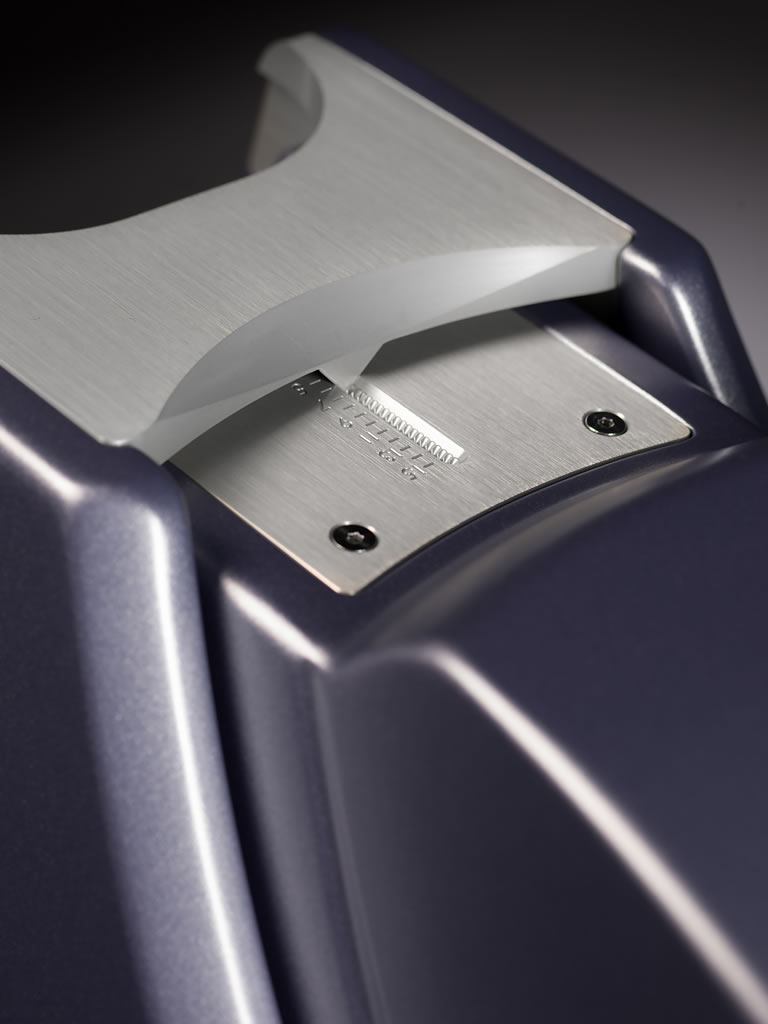
Mark V Convergent Synergy Tweeter
Wilson engineers have incorporated the WAMM Master Chronosonic version of Convergent Synergy tweeter, designated as the Mark V, into the Alexia Series 2. While developing the drivers for the Master Chronosonic, Dave and Daryl Wilson worked closely with Wilson’s team of engineers on a research project surrounding the latest in tweeter technology. Part of an ongoing effort, this recent round of research included tweeter designs with domes constructed of diamond and beryllium. After the data was carefully evaluated, and after hundreds of hours of careful listening, it was clear that Wilson’s proprietary tweeter continues to be the most musically authentic and intrinsically satisfying tweeter yet tested, regardless of diaphragm material. The latest Convergent Synergy Tweeter used in Alexia Series 2 is the same unit used in the WAMM Master Chronosonic.
Unrivaled Manufacturing Tolerances
Already the leader in the industry for extremely unyielding manufacturing tolerances, Wilson has further tightened its driver and crossover matching protocols. Part of Wilson’s culture has always been to ensure that its loyal clients have the same musical experience with their loudspeakers as Dave and Daryl do when they design them.
However, mandating the most exacting quality standards is an exercise in wishful thinking without experienced craftsmen dedicated to achieving that level of perfection day in and day out. It is difficult to imbue in those who build an ultra-high-end product the same ideals and passionate motivations of its designers. Part of Wilson’s culture and tradition for the past several decades has been to cultivate a team of craftsmen who resonate with and share in the company’s ideals. Craftsmen who thrive in an environment where being the best is the de facto expectation, who thrill at the inner reward of satisfaction of a job done exceptionally well. The Alexia is built by a passionate guild made up of individuals who love what they do.
Other Important Details
Work was also done to make the Alexia Series 2 more amplifier friendly by slightly raising the nominal impedance. A new quick release, pressure-fit resistor cover panel enables easy access to the tuning and protection resistors. The plate is also a new design with a distinctive glass element, reminiscent of the Alexandria XLF and the Alexx. Already the industry leader for crossover execution and layout, the Alexia Series 2’s crossover topology has been further refined for even greater signal-path integrity. The Alexia Series 2 uses the Mechanical Diode spike system from the WAMM, resulting in improved mechanical grounding to the floor below.
It was important to Daryl Wilson and his team of engineers that all the vital qualities that made the original Alexia so beloved among music lovers and discerning audiophiles alike were not just preserved, but elevated and enhanced. The new loudspeaker shares with the original its room-friendly footprint and its beautiful form factor—itself enhanced with a greater level of execution. Add to this the Series 2’s intrinsic musicality, its ability to portray instruments with even greater tonal and timbral authenticity, its improved alacrity and transient integrity throughout the audible spectrum, and, above all, its inherent ability reproduce the unamplified live event with unparalleled veracity for a loudspeaker this size. The Series 2 is surely destined to continue the original’s classic legacy.
Availability
Wilson is taking orders for the Alexia Series 2. Wilson will prioritize, on a first come, first served basis, distributor and dealer demonstration orders so that dealers may begin demonstrating this important new product for their clients.
Please contact Trent Workman, Jerron Marchant, or Bill Peugh for order details.
Price (U.S. MSRP)—$57,900.00 (pair) in standard colors
